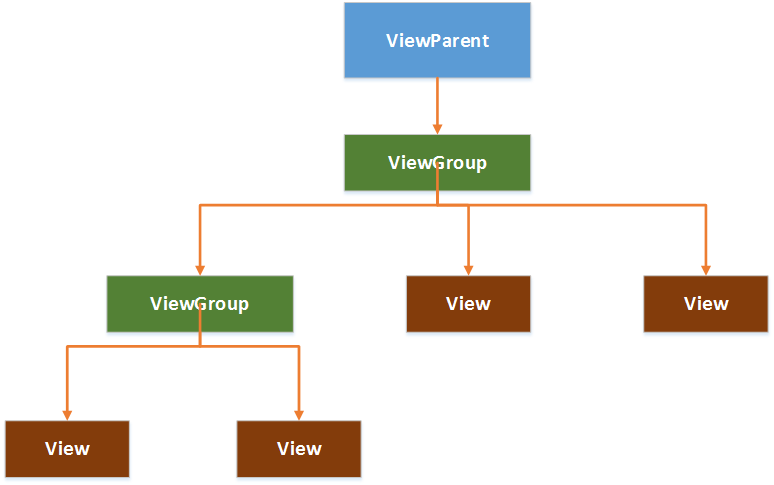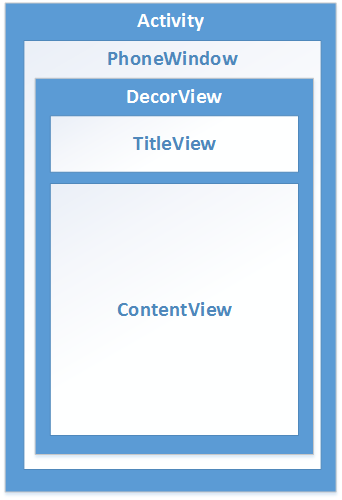
- android 横竖屏限制的配置方法
- android通过jxl读excel存入sqlite3数据库
- Android中监听未接来电的2种方法
- Android基础知识之tween动画效果
- Android性能优化以及数据优化方法
- MT6589平台通话录音时播放提示音给对方功能的具体实现
- Android多功能时钟开发案例(实战篇)
- Android ADB常用命令总结
- Android ListView实现上拉加载更多和下拉刷新功能
- Android沉浸式状态栏实现
- 模仿美团点评的Android应用中价格和购买栏悬浮固定的效果
- Android实现自动填写获取验证码功能
- android表格效果之ListView隔行变色实现代码
- Android中ActionBar以及menu的代码设置样式
- 基于Android中的 AutoCompleteTextView实现自动填充
- Android百度地图poi范围搜索
- Android仿微信联系人按字母排序
- android SDk中常用的java包介绍
- Android文件下载进度条的实现代码
- 浅谈Android app开发中Fragment的Transaction操作
- Android4.0平板开发之隐藏底部任务栏的方法
- Android编程单元测试实例详解(附源码)
- android创建手势识别示例代码
- Android HttpURLConnection.getResponseCode()错误解决方法
- Android模拟器接收UDP数据包的若干问题分析
- Android SharedPreferences的使用分析
- Android开发之获取SD卡及手机ROM容量的方法
- 如何利用matrix实现图片倒影效果
- Android中Textview超链接实现方式
- Android Mms之:深入MMS支持
Android视图控件架构分析之View、ViewGroup
在Android中,视图控件大致被分为两类,即ViewGroup和View,ViewGroup控件作为父控件,包含并管理着子View,通过ViewGroup和View便形成了控件树,各个ViewGoup对象和View对象就是控件树中的节点。在控件树中,以树的深度来遍历查找对应的控件元素,同时,上层控件负责子控件的测量与绘制,并传递交互事件。
Android控件树:

AndroidUI界面架构图:

一.测量View的工具类:MeasureSpec
1.MeasureSpec包含了测量的模式和测量的大小,通过MeasureSpec.getMode()获取测量模式,通过MeasureSpec.getSize()获取测量大小;
2.MeasureSpec是一个32位的int值,高2位为测量的模式,低30位为测量的大小,使用位运算的目的在于提高优化效率。
二.测量的模式
1.EXACTLY,精确值模式:将layout_width或layout_height属性指定为具体数值或者match_parent。
2.AT_MOST,最大值模式:将layout_width或layout_height指定为wrap_content。
3.UNSPECIFIED: View想多大就多大
三.View类默认的onMeasure()方法只支持EXACTLY模式,如果要支持其它模式,就必须重写onMeasure(),重写onMeasure()的模板代码:
package com.example.demoapp.views;
import android.content.Context;
import android.view.View;
public class MeasuredView extends View {
public MeasuredView(Context context) {
super(context);
}
@Override
protected void onMeasure(int widthMeasureSpec, int heightMeasureSpec) {
// 调用父类的onMeasure()
super.onMeasure(measureWidth(widthMeasureSpec), measureHeight(heightMeasureSpec));
// 或者直接调用父类的setMeasuredDimension(),因为父类的onMeasure()最终调用了setMeasuredDimension()
// setMeasuredDimension(measureWidth(widthMeasureSpec), measureHeight(heightMeasureSpec));
}
/**
* 测量View的width
* @param measureSpec MeasureSpec对象
* @return View的width
*/
private int measureWidth(int measureSpec) {
int result = 0;
int specMode = MeasureSpec.getMode(measureSpec);
int specSize = MeasureSpec.getSize(measureSpec);
if (specMode == MeasureSpec.EXACTLY) {
result = specSize;
} else {
result = 200;
if (specMode == MeasureSpec.AT_MOST) {
result = Math.min(result, specSize);
}
}
return result;
}
/**
* 测量View的height
* @param measureSpec MeasureSpec对象
* @return View的height
*/
private int measureHeight(int measureSpec) {
int result = 0;
int specMode = MeasureSpec.getMode(measureSpec);
int specSize = MeasureSpec.getSize(measureSpec);
if (specMode == MeasureSpec.EXACTLY) {
result = specSize;
} else {
result = 200;
if (specMode == MeasureSpec.AT_MOST) {
result = Math.min(result, specSize);
}
}
return result;
}
}
四.View的绘制
1.2D绘图必备利器——Canvas
1)获取Canvas对象的方式:
a.由方法中的参数传入,例如,View的onDraw()中有一个参数就是Canvas对象
b.通过构造方法构造,即:Canvas canvas = new Canvas(bitmap),在Canvas的构造方法传入一个Bitmap对象,即可获取一个Canvas对象。通过传入Bitmap对象构造Canvas对象的过程称为“画布的装载”,传入的Bitmap对象承载了多有绘制在Canvas上的像素信息,调用Canvas.drawXXX方法(如:Canvas.drawBitmap(bitmap, 0, 0, null))都将发生在该Bitmap对象上。
2)利用Canvas绘图
a.通过Canvas.drwaXXX进行绘制操作将直接作用于Bitmap对象,当再次刷新View的时候,我们将会被绘制的Bitmap对象发生了改变;
b.利用Canvas和Paint进行绘图;
c.不管多么复杂、精美的空间,都可以被拆分为一个个小的图形单元,我们只要找到这些图形单元,就可以将控件绘制出来。
五.ViewGroup的测量
1.ViewGroup的作用:管理子View,如子View的大小、位置;
2.ViewGroup通过遍历子View,调用子View的Measure()来获得每一个子View的测量结果;
3.ViewGroup测量完子View,调用子View的Layout()将子View放到合适的位置;
4.在自定义ViewGroup的时候,通常会重写onLayout()控制子View的显示;
5.如果需要支持wrap_content属性,必须重写onMeasure()。
六、ViewGroup的绘制
通常情况下,ViewGoup不需要绘制,但是ViewGroup会使用dispatchDraw()来绘制其子View。
七.自定义View
1.自定义View的时候,通常需要重写onDraw()来绘制View要显示的内容,如果还需要支持wrap_content属性,必须重写onMeasure();
2.通过自定义attrs属性,可以设置新的View属性;
3.View中一些重要的回调方法:
1)onFinishInflate():从XML中加载组建后回调;
2)onSizeChanged():组件大小改变时回调;
3)onMeasure():进行测量;
4)onLayout():设置显示的位置;
5)onTouchEvent():触摸事件。
4.实现自定义View的三种常用方法:
1)通过重写onDraw()对原生控件进行扩展;
2)通过组合实现新的控件,通常集成一个合适的额ViewGoup,再通过addView()给它添加指定功能的控件,从而组合成新的复合控件。
3)重写View实现全新的控件,通过重写onDraw(),onMeasure()实现绘制逻辑,重写onTouchEvent()实现交互逻辑。
5.自定义属性
1)自定义属性的方法:在res资源目录的values目录下创建一个attrs.xml的属性定义文件,文件模板:
<?xml version="1.0" encoding="utf-8"?>
<resources>
<declare-styleable name="customAttr">
<attr name="title" format="string" />
<attr name="fontSize" format="dimension" />
<attr name="fontColor" format="color" />
<attr name="background" format="reference|color" />
<attr name="fontStyle" format="enum" />
<attr name="shadeSupport" format="boolean" />
</declare-styleable>
</resources>
2)通过TypedArray获取自定义属性集,通过TypedArray.getString()、TypedArray.getColor()等方法获取属性值,模板代码:
package com.jy.myrecyclerview.test;
import android.content.Context;
import android.content.res.TypedArray;
import android.util.AttributeSet;
import android.view.View;
import com.jy.myrecyclerview.R;
/**
* Created by 123 on 2016/5/6.
*/
public class TestCustomAttrs extends View {
private Context mContext;
private AttributeSet mAttrs;
private String mTitle;
private float mFontSize;
private int mFontColor;
private int mBackground;
private int mFontStyle;
private boolean mShadeSupport;
public TestCustomAttrs(Context context) {
super(context);
this.mContext = context;
}
public TestCustomAttrs(Context context, AttributeSet attrs) {
super(context, attrs);
this.mContext = context;
this.mAttrs = attrs;
}
public TestCustomAttrs(Context context, AttributeSet attrs, int defStyleAttr) {
super(context, attrs, defStyleAttr);
this.mContext = context;
this.mAttrs = attrs;
}
private void getCustomAttrs() {
TypedArray ta = mContext.obtainStyledAttributes(mAttrs, R.styleable.customAttr);
mTitle = ta.getString(R.styleable.customAttr_title);
mFontSize = ta.getDimension(R.styleable.customAttr_fontSize, 10);
mFontColor = ta.getColor(R.styleable.customAttr_fontColor, 0);
mBackground = ta.getColor(R.styleable.customAttr_background, 0);
mFontStyle = ta.getInt(R.styleable.customAttr_fontStyle, 0);
mShadeSupport = ta.getBoolean(R.styleable.customAttr_shadeSupport, false);
ta.recycle();
}
}
6.定义回调接口,实现自定义控件的灵活控制;
7.引用UI模板
1)自定义控件需要使用命名空间进行引入:xmlns:custom="http://schemas.android.com/apk/res-auto",即将自定义控件的命名空间取名为custom
2)在XML文件中使用自定义属性的时候,就可以通过这个命名空间来引用,代码模板如下:
<?xml version="1.0" encoding="utf-8"?>
<RelativeLayout xmlns:android="http://schemas.android.com/apk/res/android"
xmlns:custom="http://schemas.android.com/apk/res-auto"
android:layout_width="match_parent"
android:layout_height="match_parent" >
<com.jy.myrecyclerview.test.TestCustomAttrs
android:id="@+id/id_recyclerview"
android:divider="#ffff0000"
android:dividerHeight="10dp"
android:layout_width="match_parent"
android:layout_height="match_parent"
custom:title="title"
custom:fontSize="12sp"
custom:fontColor="@color/colorPrimary"
custom:background="@color/colorPrimary"
custom:shadeSupport="false" />
</RelativeLayout>
九.自定义ViewGroup
1.需要重写的方法:
1)onMeasure():对子View进行测量;
2)onLayout():设置子View的位置;
3)onTouchEvent():设置触摸交互事件。
以上就是本文的全部内容,希望对大家的学习有所帮助。
- 上一篇文章: 理解Android系统Binder机制
- 下一篇文章: Android App开发中自定义View和ViewGroup的实例教程
- Android开发之ContentProvider的使用详解
- 解决EditText、ListView以及GridView同时使
- android通过蓝牙接收文件打开时无法自动选择
- Android开发技巧之像QQ一样输入文字和表情图
- 真正的android程序入口
- Android 屏蔽和捕获Home键的示例代码
- Android中自定义ScrollView代码实例